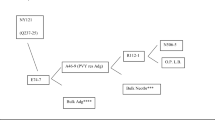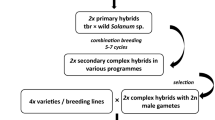Abstract
Potatoes had probably been introduced into North America from Europe by the end of the 17th Century. Several significant introductions since then have added to the initial germplasm. The Chilean clone “Rough Purple Chili”, introduced by Chauncey Goodrich in 1851, is in the pedigrees of almost all modern varieties. The initiation of plant exploration and establishment of germplasm centers in the 1920’s greatly expanded the germplasm base. Utilization ofS. demissum for blight resistance led to the development of many new varieties in the 1940’s. The German variety “Jubel” was widely used in breeding for scab resistance and “Villaroela” from Chile, for virus resistance. “Katahdin”, with several European introductions as well as the South American varieties “Daber” and “Rough Purple Chili”, in its pedigree, was widely used as a parent from the 1930’s to the 1960’s. More recently, the convenience of obtaining germplasm from the IR-1 project, and the genetic, cytogenetic, and adaptation studies based on this germplasm, have fostered a new wave of the use of exotic material. This research, coupled with extensive screening for valuable traits, makes the use of exotic germplasm more feasible and more productive.
Compendio
La papa posiblemente fué introducida a America del Norte desde Europa al final del siglo XVII. Varias introduciones significantes han sido agregadas al germoplasma inicial. El clon chileno “Rough Purple Chili”, introducido por Chauncey Goodrich en 1851, esta en el linaje de casi todas las variedades modernas. La iniciación de expediciones para colectar variedades nativas cultivadas y silvestres y la establacimiento de centros de germoplasma en los 20’s logró una gran expansion grande del base de germoplasma. Utilización deS. demissum para resistencia aPhytopthora infestans impulsó el desarollo de muchas variedades nuevas en los 40’s. La variedad aleman “Jubel” fue usada mucho en cruces para resistencia a sarna y la variedad “Villaroela”, de Chile, para resistencia a virus. “Katahdin”, junto con diferentes introducciones europeos asi como variedades suramericanos “Daber” y “Rough Purple Chili”, en su genealogia, fueron usadas con mucha frequencia como padres desde los 30’s hasta los 60’s. Mas recientemente, la conveniencia de obtener germoplasma del Projecto IR-1, y los estudios geneticos, cytogeneticos, y de adaptación basado en este germoplasma, han impulsado una nueva ola de uso de material de papa exótica. Este tipo de investigación, ademas de ensayos extensivos buscando caracteristicas valiosas, hace mas factible y productivo el uso de germoplasma exotico.
Similar content being viewed by others
Literature Cited
Carman, E.S. 1874–1889. The Rural New Yorker. Volumes 29–48.
Chase, R.W. 1984. North American potato variety inventory. Certification Section. Potato Assn of America. 13 pp.
DeJong, H. and T.R. Tarn. 1984. Using germplasm in potato breeding in Canada. Canada Agriculture No. 3 & 4:12–15.
Ellenby, C. 1952. Resistance to the potato eelwormHeterodera rostochiensis Woll. Nature 170: 1016.
Folsom, D. 1945. Potato varieties: The newly named, the commercial, and some that are useful in breeding. Am Potato J 22: 229–242.
Glendinning, D.R. 1979. Enriching the potato gene-pool using primitive cultivars. Proceedings of the Conference: Broadening the Genetic Base of Crops. 1978: 39–45.
Glendinning, D.R. 1979. The potato gene-pool, and benefits deriving from its supplementation. Proceedings of the Conference: Broadening the Genetic Base of Crops. 1978: 187–194.
Glendinning, D.R. 1983. Potato introductions and breeding up to the early 20th century. New Phytol 94: 479–505.
Goodrich, C.E. 1863. The origination and test culture of seedling potatoes. Transactions of the NYS Agricultural Society 23: 89–134.
Hanneman, R.E. Jr. 1989. The potato germplasm resource. Am Potato J (In Press).
Hawkes, J.G. 1979. Genetic poverty of the potato in Europe. Proceedings Conference: Broadening Genetic Base Crops, Wageningen 1978: 19–27.
Hougas, R.W. 1956. Foreign potatoes, their introduction and importance. Am Potato J 33: 190–198.
Hougas, R.W. and R.W. Ross. 1956. The use of foreign introductions in breeding American potato varieties. Am Potato J 33: 328–339.
Johnston, G.R., R.G. Rowberry, and J.F. Alex. 1983. Conestoga: A new early potato cultivar with very good table and chipping qualities. Am Potato J 60: 193–197.
Mendoza, H.A. 1989. Population Breeding as a tool for germplasm enhancement. Am Potato J (In Press).
Mendoza, H.A. and F.L. Haynes. 1974. Genetic relationship among potato cultivars grown in the United States. HortSci 9(4): 328–330.
Rathlef, H. von. 1932. Die Stammtafeln des Weltsortiments der Karoffel und ihre generativ fruchtbaren sorten. Kuhn-Archiv 33: 296–431.
Ross, H. 1979. Wild species and primitive cultivars as ancestors of potato varieties. Proceedings of the Conference: Broadening the Genetic Base of Crops. 1978: 237–1243.
Ross, H. 1986. Potato breeding — problems and perspectives. Advances in Plant Breeding 13. 132 pp.
Author information
Authors and Affiliations
Rights and permissions
About this article
Cite this article
Plaisted, R.L., Hoopes, R.W. The past record and future prospects for the use of exotic potato germplasm. American Potato Journal 66, 603–627 (1989). https://doi.org/10.1007/BF02853982
Accepted:
Issue Date:
DOI: https://doi.org/10.1007/BF02853982




